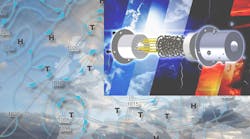MIT engineers have created the first 3D-printed plasma sensors that can be used on orbiting spacecraft. These sensors, known as retarding potential analyzers (RPAs), are used by satellites to determine the atmosphere’s chemical composition and ion energy distribution. The MIT team used a process developed for 3D printing with plastics. It lets them create sensors with complex shapes that will survive the wide temperature swings spacecraft encounter in lower Earth orbit.
The 3D-printed sensors perform as well as sensors made in cleanrooms, so they cost much less and do not take weeks of intricate fabrication. By contrast, the 3D-printed sensors can be manufactured for tens of dollars in a matter of days.
RELATED
Wearable Sensors Detect Respiratory, Cardiac Symptoms
3D-Printing Deposition Method Augments Sensor Durability
Engineers 3D Print a Living Skin-Patch Sensor
3D Printing Helps Researchers Improve Electrochemical Reactors
Due to their low cost and speedy production, the sensors are ideal for CubeSats, according to the MIT team. These inexpensive, low-power, and lightweight satellites are often used for communication and environmental monitoring.
The researchers printed the RPAs out of a glass-ceramic material more durable than traditional sensor materials such as silicon and thin-film coatings.
An RPA was first used in a space mission in 1959. The sensors detect the energy in ions, or charged particles, which are floating in plasma, which is a superheated mix of molecules present in the Earth’s upper atmosphere. Aboard an orbiting spacecraft like a CubeSat, the versatile instruments measure energy and conduct chemical analyses that can help scientists predict the weather or monitor climate change.
The sensors contain a series of electrically charged meshes perforated with tiny holes. As plasma passes through the holes, it strips away electrons and other particles, leaving only ions. These ions create an electric current that is measured and analyzed by the sensor.
A housing aligns the meshes, which is key to the sensor’s performance. It had to be electrically insulating and able to withstand sudden, drastic temperature swings. The team chose Vitrolite, a printable glass ceramic with the needed capabilities. It can withstand temperatures as high as 800°C without breaking down, whereas polymers used in semiconductor RPAs melt at 400°C.
3D printing ceramics typically involves fusing ceramic powder into the right shape using a laser. But this often leaves the material coarse and creates weak points due to the laser’s heat.
To avoid these problems, the MIT researchers used vat polymerization, a 3D printing process developed decades ago for printing with polymers and resins. With vat polymerization, 3D objects are built one layer at a time by submerging them repeatedly into a vat of liquid material—in this case Vitrolite. UV light cures the material after each layer is added, and then the process is repeated. Each layer is only 100 microns thick, so complex parts have smooth, pore-free surfaces.
The sensors were inexpensive to produce and could be made quickly, so the team prototyped four designs.
One design was especially effective at capturing and measuring a wide range of plasmas, like those satellites would encounter in orbit. Another was well-suited for sensing extremely dense and cold plasmas, which are typically only measurable using ultra-precise semiconductor devices.
The MIT team will now look into improving the 3D printing process by reducing the layer thickness or pixel size to more precisely build make complex hardware. Moreover, 3D-printed sensors would make them compatible with in-space manufacturing. The team also wants to explore the use of artificial intelligence to optimize sensor design for specific uses, such as greatly reducing their mass while ensuring they are structurally sound.
“Additive manufacturing can make a big difference in the future of space hardware. Some people think that when you 3D-print something, you have to concede less performance. But we’ve shown that is not always the case. Sometimes there is nothing to trade off,” says Luis Fernando Velásquez-García, a principal scientist in MIT’s Microsystems Technology Laboratories.
